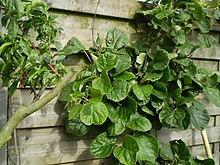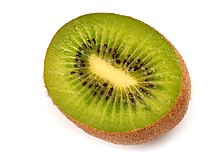
Kiwifruit or Chinese gooseberry is the edible berry of several species of woody vines in the genus Actinidia. The most common cultivar group of kiwifruit is oval, about the size of a large hen's egg: 5–8 centimetres in length and 4.5–5.5 cm in diameter. It has a thin, fuzzy, fibrous, tart but edible light brown skin and light green or golden flesh with rows of tiny, black, edible seeds. The fruit has a soft texture with a sweet and unique flavour.

The Actinidiaceae are a small family of flowering plants. The family has three genera and about 360 species and is a member of the order Ericales.

Actinidia is a genus of woody and, with a few exceptions, dioecious plants native to temperate eastern Asia, occurring throughout most of China, Taiwan, Korea, and Japan, and extending north to southern areas of Russian Far East and south into Indochina. The genus includes shrubs growing to 6 metres tall, and vigorous, strong-growing vines, growing up to 30 m (100 ft) in tree canopies. They mostly tolerate temperatures down to around −15 °C (5 °F), and some are much hardier.
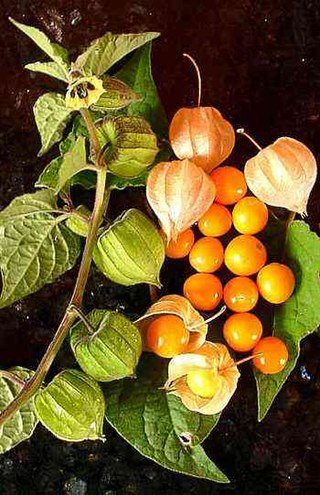
Physalis peruviana is a species of plant in the nightshade family (Solanaceae) native to Chile and Peru. Within that region, it is called aguaymanto, uvilla or uchuva, in addition to numerous indigenous and regional names. In English, its common names include Cape gooseberry, goldenberry and Peruvian groundcherry.
HortResearch was a Crown Research Institute of New Zealand. The focus of research in this company was mainly in the development of new fruit varieties and other food products. It was probably most recognised for its plant breeding of various kiwifruit varieties, including new cultivars of Actinidia (genus) chinensis and arguta (species).
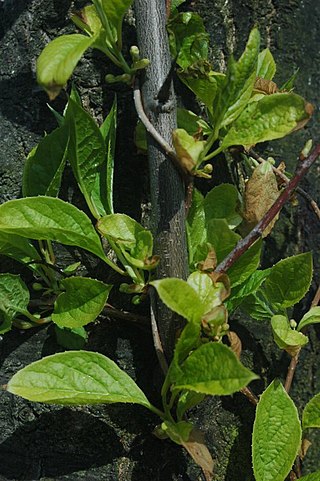
Schisandra chinensis, whose fruit is called magnolia berry or five-flavor fruit, is a vine plant native to forests of Northern China, the Russian Far East and Korea. Wild varieties are also found in Japan. It is hardy in USDA Zone 4. The fruits are red berries in dense clusters around 10 centimetres (3.9 in) long.

Actinidia arguta, the hardy kiwi, is a perennial vine native to Japan, Korea, Northern China, and the Russian Far East. It produces a small kiwifruit without the hair-like fiber covering the outside, unlike most other species of the genus.

Rosa chinensis, known commonly as the China rose, Chinese rose, or Bengal rose, is a member of the genus Rosa native to Southwest China in Guizhou, Hubei, and Sichuan Provinces. The first publication of Rosa chinensis was in 1768 by Nikolaus Joseph von Jacquin in Observationum Botanicarum, 3, p. 7 & plate 55.

Actinidain is a type of cysteine protease enzyme found in fruits including kiwifruit, pineapple, mango, banana, figs, and papaya. This enzyme is part of the peptidase C1 family of papain-like proteases.
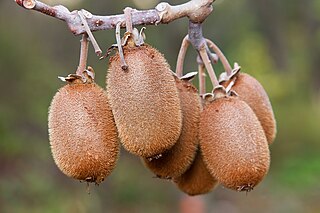
Actinidia chinensis(Planch.), known commercially as the golden kiwifruit, is a fruiting vine, native to China. It is one of some 40 related species of the genus Actinidia, and closely related to Actinidia deliciosa, which is the source of the most common commercial kiwifruit. Fruit colour may vary from green to lime green or gold, depending on breeding.

Actinidia kolomikta, the kolomikta, miyamatatabi, super-hardy kiwi, or variegated-leaf hardy kiwi, is a species of flowering plant in the family Actinidiaceae, native to temperate mixed forests of the Russian Far East, Korea, Japan and China.

Kiwifruit or kiwi is a major horticultural export earner for New Zealand. New Zealand developed the first commercially viable kiwifruit and developed export markets, creating the demand for the fruit that exists today. Today New Zealand is the third largest kiwifruit producing country, next to China and Italy, and holds approximately 30% of the market share. In the 2008–2009 season the value of New Zealand kiwifruit exports was NZ$1.45 billion.
Actinidia melanandra, known as purple kiwi or red kiwi is a fruiting plant in the genus Actinidia, which contains three commercially grown species of kiwifruit. The plant is native to parts of Hubei, Sichuan, and Yunnan provinces of China. The fruit has a fuzzy purple skin with reddish flesh. Although the fruit is edible, is not commercially cultivated, however it is occasionally sold as a landscape plant under the erroneous name Actinidia melandra.
Allan Ross Ferguson is a New Zealand botanist who has made significant contributions in the field of kiwifruit scientific investigation. The standard author abbreviation A.R.Ferguson is used to indicate this person as the author when citing a botanical name.

The gold kiwifruit or yellow kiwi is a variety of kiwifruit developed by the company Zespri International Ltd. The yellow kiwi is a different species but of the same genus as the green one.

Actinidia eriantha is a species of flowering plant in the Chinese gooseberry family Actinidiaceae, native to southern China. A large climbing shrub, it is found in low mountain forests and grassy thickets at elevations from 200 to 1,000 m. It fruits in November, which has precluded its development as a commercial crop.
Actinidia henryi is a species of flowering plant in the Chinese gooseberry family Actinidiaceae, native to southern China. A semi-evergreen climbing shrub, it is found in mountain forests and thickets at elevations from 1,400 to 2,500 m. It has the lowest known vitamin C content of any kiwifruit.
Actinidia callosa, the Himalayan kiwi vine, is a species of flowering plant in the Chinese gooseberry family Actinidiaceae. It is native to the Himalayas, central and southern China, Taiwan, Myanmar, Vietnam, Peninsular Malaysia, and Sumatra.

